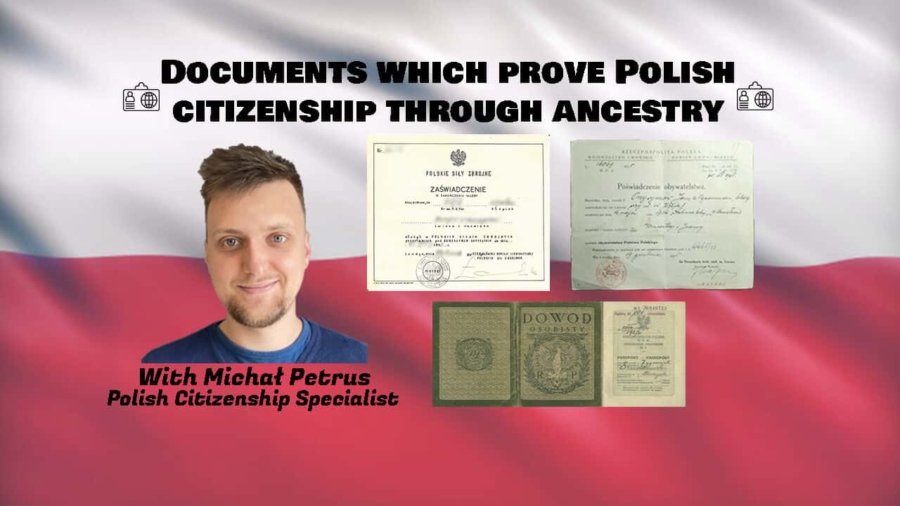Having only briefly touched upon the range of documents which prove Polish citizenship through ancestry in previous posts on obtaining Polish citizenship by right of blood and claiming Polish citizenship by descent on the basis of an ancestor who fought in the Polish army under British command, I set myself the task of interviewing a Polish Citizenship Specialist who can shed more light on these documents and Polish citizenship law in general.
It was by chance that I came across Michał Petrus speaking about claiming Polish citizenship by descent on a live podcast stream on Youtube. Michał is a genealogy enthusiast who’s been dealing with the issue of confirming Polish citizenship by descent since 2019. He represents Your Roots in Poland, a genealogical and citizenship company based in Kraków.
Before we speak about all the documents which prove Polish citizenship through ancestry, can you tell my readers a little bit about yourself?
Sure. I graduated from Jagiellonian University with a degree in history in 2014. I soon branched out into the area of citizenship where I could use my historical knowledge to carry out searches for documents in the archives and registry offices.
With the passing of time, I got to know more about past and present Polish citizenship laws and judicial decrees. All of this helped me to become a Polish citizenship expert. I soon went on to set up a Department of Citizenship on my own with Your Roots in Poland.
Let’s talk a little about vital records, such as birth certificates. Vital records can’t be used as a basis to claim a Polish citizenship certificate because Polish citizenship law revolves around “right of blood” (Jus sanguinis), and not “right of soil”. Do applicants still have to locate and order their ancestor’s birth, marriage and death certificates for the sake of their application?
Absolutely. Vital records may not be proof of citizenship. However, they are proof of lineage. With the applications I’ve dealt with, I’ve always put emphasis on submitting both Polish administrative records and proof that you are a descendant in this lineage. It’s necessary to secure both birth and marriage certificates - marriage for passing on citizenship in male lineage. In male lineages, you would most likely need to prove that your ancestor was born in wedlock.
I also know for a fact that some representatives may try to carry out the procedure “upside down”, so to speak. If they fail to secure key administrative records, such as population censuses, which prove citizenship itself, they may just provide vital records that are post-1920. Therefore, an applicant may prove, for example, that his grandfather was born in Poland in 1923. This applicant may be aware that his grandfather wasn’t necessarily a Polish citizen but his parents at the time of his birth had to be in Poland. Moreover, the applicant may also have records from the Arolsen archives, or the International Centre on Nazi Persecution, proving that their ancestor’s country of residence prior to the Second World War was Poland.
All in all, some representatives do submit vital records - or supporting documents - to show that applicants have some basis to claim their Polish citizenship certificate. Of course, the evidence is not as solid as administrative records. However, it’s still possible to get Polish citizenship by descent in this way as well.
Are many of your clients refused Polish citizenship due to issues with their ancestors being born out of wedlock? Go into how the major Acts on Citizenship of the Polish State in 1920, 1951 and 1962 changed the landscape surrounding the importance of one being born in wedlock.
Between 1920 and 1951, Polish citizenship law itself was very focused on the male figure. The citizenship of both women and children most often depended on the status of their husbands and fathers, respectively. If a child was born in wedlock, it always inherited citizenship from the father. The only instance in which citizenship would have been inherited from the mother’s side was if the said mother was a maiden and the child was born out of wedlock.
Interestingly, we don’t have to prove that the main ancestor, for example, the grandfather or grandmother, was born in wedlock unless he/she left Poland as a minor before the age of 18. In this case, we have to go back one generation to check the state of play with the great-grandfather. Still, this rarely needs to be done because as long as we have administrative proof that the main ancestor was a Polish citizen, he/she can be born out of wedlock and this will not have an impact on the application. Essentially, the law from 1920 enables citizenship to be handed down from father to his born-out-of-wedlock child on one condition - if the father declared his paternity before the child turned 18. Moreover, this had to be done in the presence of the Polish authorities.
Between 1951 and 1962, wedlock does not have to be proven at all, neither for male nor female inheritance. Citizenship was inherited from both father and mother.
Starting from August 1962, up to the present day, there is a wedlock requirement once again but only when it concerns passing on citizenship from a male to a child. The matter of citizenship is not so focused on the father figure any more. Nevertheless, if you want to trace your citizenship through your father’s side, you need to prove that you were either born in wedlock or that you’ve been acknowledged up to one year from birth.
Regarding whether these laws can derail an application or not, citizenship laws can be full of loopholes. The interpretation of the said laws depends on the clerk in the provincial office. It’s very much a matter of who you end up with and whether the person analysing your case is willing to gloss over the main difficulties and try to help you, or perhaps they’re just focused on rejecting your application. I know that in the provincial office in Warsaw, the clerks claim that they always try to see the good side of applications.
Bonus 1 – Michał Petrus guesting on the Kult America Podcast
Check out part of an interview Michał gave to the Kult America Podcast where he speaks about why children born out of wedlock couldn’t get Polish citizenship by descent
Bonus 2 – Case studies which explain Polish citizenship laws pertaining to children born in and out of wedlock
Case study 1:
A client’s paternal grandfather was born in 1904 but left Poland in 1938. No wedlock check for him. A wedlock check is necessary for the client’s father – because the father was born in 1940 (pre-1951). A wedlock check is also necessary for the client, as the client was born in 1965 (post-1962).
Case study 2:
A client’s maternal Grandfather was born in 1922 but left Poland in 1928. A wedlock check is necessary for him as he left Poland as a minor. Therefore, we need to turn to the client’s great-grandfather to prove citizenship. A wedlock check for the mother is not necessary, as the mother was born in 1960 (between 1951-1962). Moreover, a wedlock check is not necessary for the client, as you don’t have to prove maternity in Polish law. This stems from Roman civic law and is part of the legal tradition in Poland.
The most valuable documents which prove Polish descent are an ancestor’s passport or ID document. Presumably, not many of your clients have had the fortune of possessing a pre-World War Two passport or ID document?
You are correct that those passports and ID documents, especially pre-war, are very precious. Most of the pre-Second World War documents in Polish archives were destroyed, in major cities at least, during the war itself. Passports were not exempt from this fate, of course. However, there are a couple of archives that have passport questionnaires which are still strong documents. This is because they have a photograph and personal details of the ancestor. Occasionally, they contain a fingerprint and signature.
When I went to the state archive in Łódź in 2020, I asked for all the passports they had. They gave me a box which contained only around 15 or 16 passports. To put things into context, around 650,000 people live in Łódź today. The city had a similar population before the war. There are some interesting stories surrounding why those 15 passports were left with the authorities. For example, one was left because somebody didn’t pay their bill at a restaurant and the passport was thus confiscated.
Even though the chances of tracking down an ancestor’s passport or ID document among old family memorabilia, let alone in the archives, are very slim, one can still turn to the passport index which is a list of passports that were issued in a certain period or year. This is just a plain table that gives one’s name, surname, date of birth, passport number and the year when the passport was issued, that is for the pre-war period.* Moreover, it’s possible to check whether the archives have an ancestor’s passport questionnaire, as I’ve already mentioned.
* Post-war passport files are held entirely by the Institute of National Remembrance. Immigration and emigration were closely monitored by the communist government.
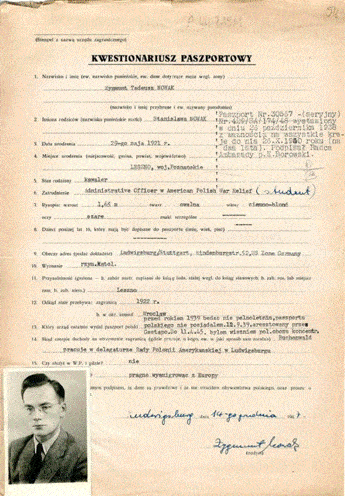
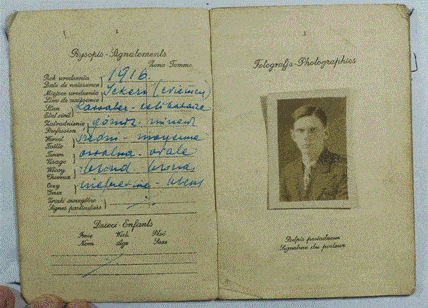

Can you talk about some of the other administrative records, common ones or not, which can help people verify their Polish citizenship status?
When it comes to documents which prove Polish citizenship through ancestry, population censuses carry a lot of weight. Before 1945, one was automatically a citizen if they were domiciled in Poland. This also applies to the Jewish populace with ghetto lists during the war. These documents were obviously created for German administrative purposes. Nevertheless, they are acknowledged as proof of domicile of Jewish ancestors in Poland.
I’d also like to mention military documents, especially those issued in pre-war Poland. If you know the unit your ancestor served in - and this is a requirement - we can query the Military Historical Bureau in Warsaw. They have partial records for most of the units.
We can also acquire Prisoner of War (POW) records from the Central Museum of Prisoners-of-War just outside Opole.
Finally, we may also search for tax records and voters’ lists. I wouldn’t consider voters’ lists as a rare source of documentation. However, they’re not as common as population censuses.
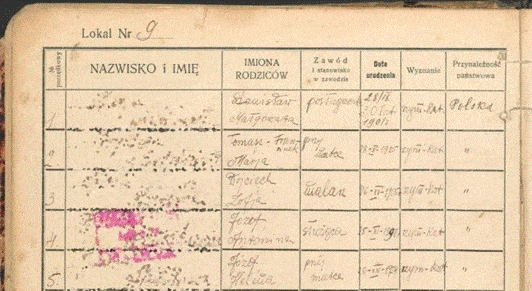
There’s another document called the Karta Rejestracyjna Reemigracyjna, or Re-emigration Registration Card. Even though it functioned as a one-way travel document, permitting Polish citizens to re-enter their motherland, is it deemed by the Polish authorities as a 100% legitimate passport?
Yes. The authorities treat it as a legitimate document. It was actually part of one’s passport because it was more like a booklet which was added to or tucked inside the actual passport. It allowed re-entry to Poland and is a perfectly valid document.
Searching for documents which prove Polish citizenship through ancestry inevitably leads you to general register offices, church archives, state archives, regional archives and military archives. Describe your experience in these various types of archives. Is one type of archive notoriously trickier to navigate than all the others?
The Polish State Archives, as well as the many regional archives, like any other public offices and institutions in Poland, all have different interpretations of rules and laws.
The trickiest archives to navigate are the ones with the smallest number of records. This includes archives in Warsaw because the city was totally levelled to the ground in 1944 and not many records survived. Moreover, parts of northeastern, southeastern and eastern Poland were stripped of any valuable documents for the purpose of claiming Polish citizenship.
The best archives are the ones with a lot of materials. The archives in Łódź, Poznań and Kraków have a lot of information. One mustn’t forget that the borders were quite different before the end of the war. Therefore, searching for documents which prove Polish citizenship through ancestry in Lower Silesia and Pomerania is not possible at all because they were part of Germany before 1945.
Coinciding with border changes in the east, there are still very many Polish records in Ukrainian, Belarusian and Lithuanian archives. Only vital records were transferred to Poland, although some still remain in archives in the said countries. As for administrative records, virtually none were transferred to Poland. So if you want a population census from Lviv, Ukraine, you need to do the query in Ukraine. For archive searches in Belarus and Ukraine, the situation is obviously very difficult nowadays. You need a genealogist that would be willing to go there.
I would say that 90% of the searches have to be done physically on-site because Poland is not so advanced when it comes to the digitisation of records. Slowly but surely, however, vital records are being digitised. Regarding administrative records, the majority of them are still under GDPR. Second of all, they aren’t as popular as vital records when it comes to searches conducted by private genealogists.
As a British person with a Polish grandfather who fought for the Polish Army under British command, I recall having to do three things to get my Polish Citizenship confirmed. First of all, I had to get a letter from the Polish Historical Disclosures section at RAF Northolt stating that my grandfather had never served in the British Armed Forces and that he had served in the Polish Forces under British command. Secondly, I had to obtain a copy of my grandfather’s book of military records (Zeszyt ewidencyjny). Finally, I had to write to the National Archives in Kew, London, to request a “Letter of no evidence” – a document stating that my grandfather did not acquire British citizenship.
Apart from some sloppiness on the part of the National Archives, everything went quite smoothly. Can you share your experience with helping British people to apply for Polish citizenship if they had Polish relatives who fought in the Second World War? I’m particularly interested in cases where army records have been very hard to come by.
Indeed. Very well-preserved military records can be found in the UK and I do consider them to be strong documents which prove Polish citizenship through ancestry. There was a period of time when there did exist Free Polish Forces under British command. This was treated as an ally unit which recruited mostly from Poles that were deported to the USSR. When the USSR joined the allies, the said Poles were allowed to leave the Soviet Union and form their own army. This was called the Anders’ Army. Soldiers fought their way through Iran, Palestine and Italy, eventually ending up in the UK.
As for the soldiers in the Anders’ Army, it was a case of 50/50. Around 50 per cent of them returned to Poland after the war. The other half remained in the UK or moved to other Commonwealth countries, such as Canada, South Africa, New Zealand and Australia. A small number went to the USA, Mexico and South American countries.
Regarding the documentation you mentioned, we need to prove that someone was part of the Free Polish Forces. At the same time, we also need to prove that the said person didn’t remain in the military. When the Free Polish Forces disbanded, the Polish Resettlement Corps, or PRC, was set up by the British Government in 1946. When this dissolved in 1949, members of the Corps took up civilian work in various sectors, such as mining. However, a small number of veterans in the PRC were transferred to the RAF. Unfortunately, carrying out military service for another country apart from Poland before 1951 meant one’s Polish citizenship would be stripped. The only exception was being part of the Allied forces, namely the Free Polish Forces, during the Second World War. This verifies a Polish ex-serviceman’s Polish citizenship.
As for naturalisation, it is quite a difficult subject. The 1920 law stated that naturalisation leads to the loss of Polish citizenship. This applies to women, without any exceptions. For men, we have something called the “military paradox”. With naturalisation, they would have lost their Polish citizenship. However, at the same time, the 1920 Polish citizenship law specified that if you are subject to the Polish military draft, you cannot lose Polish citizenship. Therefore, the law is contradictory - you can lose citizenship through naturalisation yet you cannot lose citizenship because of the draft. In reality, people that were born after 1901 were always considered able-bodied and thus liable to conscription. At first, the draft age was 50, then it was moved to 60, and then back to 50 again. Therefore, naturalisation had no impact whatsoever on those born after 1901.
For people that were born at the end of the nineteenth century, we always have to calculate their eligibility for the draft. We also need to check the date they were naturalised and, if they lost citizenship, whether their children adults or minors.
It’s worth pointing out that naturalisation after 1951 wasn’t damning at all. Dual citizenship was allowed. All in all, we need to check this brief period between the start of service in the Free Polish Forces and 1951. In essence, we need to confirm that the ancestor didn’t serve in the British Army and naturalisation didn’t occur.
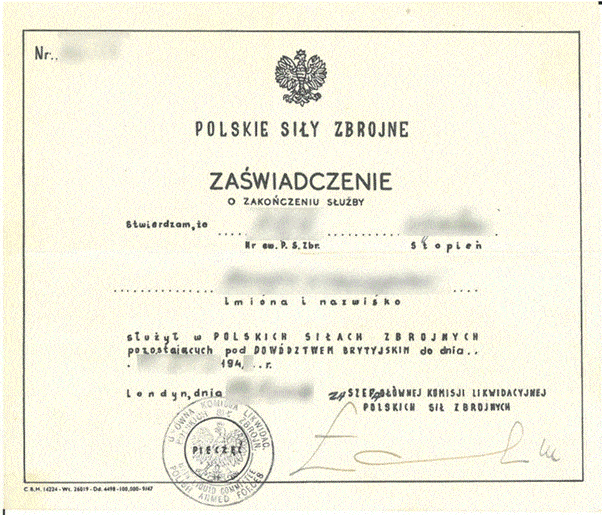
Have you had many cases where you’ve had to gather paperwork pertaining to Poles who lived in either the German, Austrian or Russian Empire prior to 1920?
Certainly, those cases are the most difficult ones when it comes to securing documents which prove Polish citizenship through ancestry. The 1920 law specified that people were considered to be Polish as long as they could prove they had a domicile in Polish territory as it was in 1920. This territory may have previously been part of the German, Austrian and Russian Empires. As long as somebody stayed within the new Polish borders established after 1918, they received Polish citizenship in 99.9% of cases.
The tricky part is if somebody left before Poland gained independence in 1918 or even before Poland introduced the citizenship law in 1920. So if one’s great-grandparents or grandparents left Poland during the First World War or even at the start of the century, we would have tremendous trouble proving Polish citizenship. To express their desire to become Polish citizens, those ancestors would have had to have gone to the Polish consulate in their new country and report themselves as ex-subjects of Germany, Austria or Russia. They would have had to have declared themselves as being Polish, or having Polish ethnicity, and that they speak the Polish language. Most people didn't employ this privilege because they were either already naturalised citizens in, for instance, the USA or Britain and thus didn't have any motivating factor to claim their Polish citizenship.
Some people who had left Poland were considered stateless because the Austro-Hungarian, German and Russian Empires were all dissolved to varying degrees. Those people simply didn’t care about being stateless.
In summary, we would need proof of the ancestor’s domicile in the said empires and some proof that they had at least made an enquiry to claim Polish citizenship or at least made some sort of move towards it.
There’s a plethora of documents out there which can verify your Polish citizenship status
This 30-minute interview with Mr Petrus opened my eyes to the sheer range of documents those with Polish roots can submit to the authorities in an attempt to verify their Polish citizenship status. Frankly, Mr Petrus only just scratched the surface when it comes to documents which prove Polish citizenship through ancestry. Feasibly, we could have gone on to talk about many other documents, such as property records, domicile records and military medal records, such as The War Order of Virtuti Militari. Another time perhaps.
Further reading for British and American citizens:
Polish Citizenship for American citizens of Polish Descent
Obtaining Polish citizenship from the President of Poland – With Michał Petrus
Claiming Polish Citizenship by Descent – Complete FAQ Guide
Polish citizenship for British Citizens of Polish descent – With Michał Petrus

